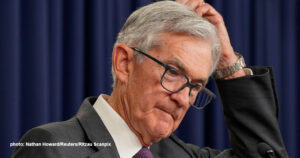Da den amerikanske centralbank for nylig hævede renten, sendte det aktierne opad. Men lukker investorerne øjnene for, hvad der ligger forude? Det er, som om markedet kun ser, hvad det VIL se. Mange tror, at Fed er ved at slutte kampen mod inflationen. Men det er forkert. Der er mere modvind og volatilitet, end der allerede er indregnet i kurserne. Derfor skal investorerne være forsigtige med at skifte strategi fra en langsigtet, risikobaseret strategi, vurderer Morgan Stanley.
Should Investors Trust the Latest Rally?
Investors cheered the Fed’s recent interest-rate hike, sending stocks higher, but are markets turning a blind eye to what may lie ahead?
The Federal Reserve’s 75-basis-point interest-rate hike last week drew a cheerful response from markets. Stocks rallied, especially the tech-heavy Nasdaq index, while short-term Treasury yields fell, reflecting an expectation that monetary policy could soon ease.
Such a reaction is curious, given that the Fed did not appear particularly dovish with its latest decision, nor did it signal a coming pivot from its aggressive tightening path.
This may be a case of markets seeing only what they want to see. Yes, data is accumulating that might give the Fed a reason to ease off on policy:
- Inflation seems to be slowing. Most commodities are in bear markets—down at least 20% from their peaks—and gasoline prices have dropped, likely contributing to a decline in inflation expectations to 2.8% in July in the University of Michigan’s closely watched consumer surveys.
- Gross domestic product fell 0.9% in the second quarter—a second consecutive quarterly contraction that meets the technical definition of a recession.
These developments seem to be encouraging investors to call an end to the inflation fight and anticipate rate cuts from the Fed, while counting on lower rates to support higher valuations for stocks.
But we doubt the narrative is quite so simple. As we’ve noted multiple times, there may be more headwinds and volatility ahead that aren’t priced in. Here’s what investors need to keep in mind:
- Policy operates with a lag, and we have yet to feel its full economic impact. Remember, we are in the midst of the most aggressive Fed tightening cycle in more than 40 years, with rates having risen more than 2 percentage points in the past four months and on track to rise more before the program is over. The Fed has to manage rate hikes at the same time as reducing the size of its balance sheet, something the central bank has never navigated before. This remains a challenge, and the implications of higher rates and tighter financial conditions are still in front of us.
- The economy still faces unique headwinds and a host of unknowns. The Russia-Ukraine conflict and China’s economic recovery, not to mention the lingering impact of COVID itself, remain outside the control of the Fed. Labor markets also remain strong, which lends support to the idea that the U.S. is not quite in a recession and that the Fed will continue on its tightening path. The job market’s strength also could keep wage pressures elevated—which, among other factors, is likely to hinder corporate profitability.
Given the magnitude of these unknowns, we think the recent market sentiment may be overly optimistic. It might be more understandable if valuations were particularly attractive. But they’re not. Current equity risk premiums (ERP)—the excess potential return over a risk-free rate that investors may get for taking on the higher risk of stock investing—are around 3%, which is below the average ERP of about 3.5% over the past 13 years. During times of Fed tightening, historical data point to ERPs above 4.5% as attractive entry points. We would prefer to wait for wider premiums that more appropriately value the true uncertainty in today’s environment.
At this point, investors should avoid big changes to asset allocations that differ from long-term risk-based targets. Instead, look to deploy cash opportunistically to investments that demonstrate positive after-inflation cash flow and growth at a reasonable price.








